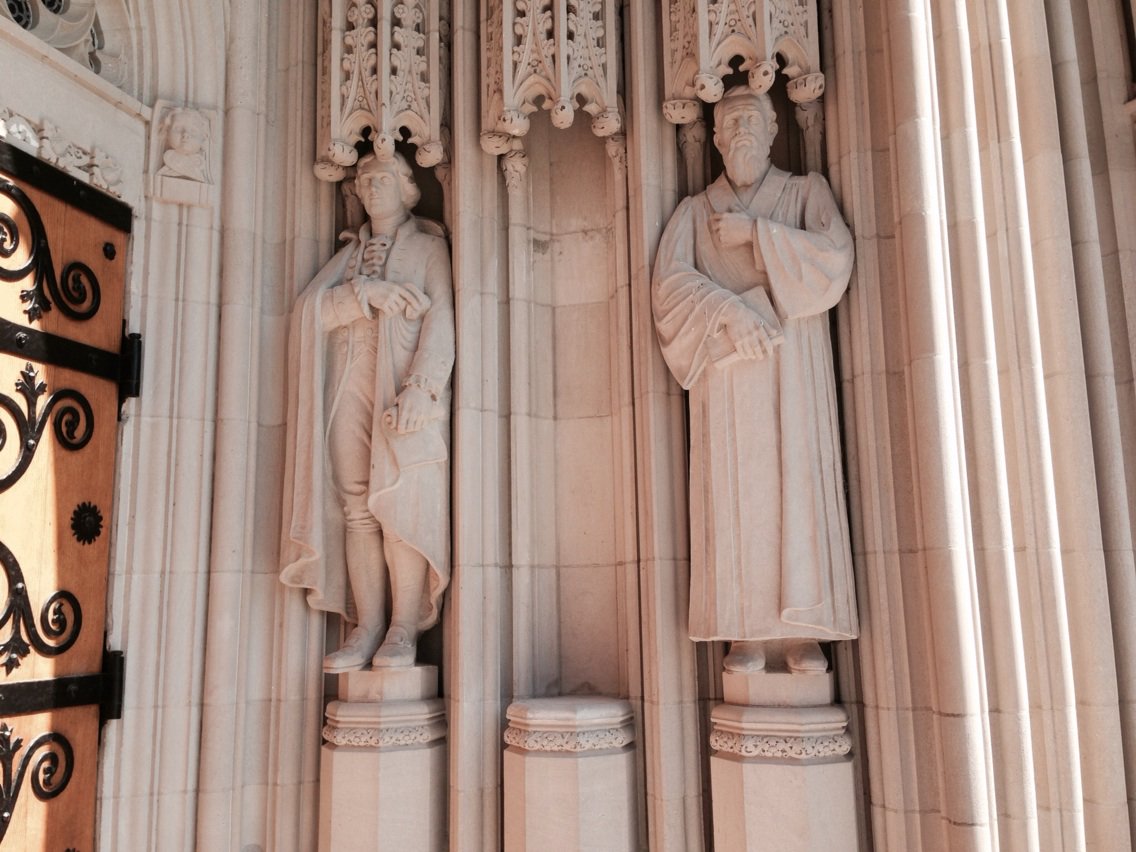Confederate Monuments / Monument(al) Mistakes
In these past two months I have interrupted the pace of my usual Tuesday-Friday blog postings. World and national events currently take precedence in my life over writing about my chosen topics of language, love and adventure. During this time I have been reposting blogs that are as relevant now as when I first posted them. Today’s blog on Confederate monuments originally appeared on September 5, 2017.
Title image: Baldwin Auditorium, East Campus, Duke University with statue of Benjamin N. Duke
Monument(al) Mistakes: The Benign
I’ve always loved Duke University’s East Campus with its Georgian architecture. Maybe it’s because I lived there when I was a Duke undergraduate and it was the women’s campus. Since 1995 it’s been the freshman campus. I lived there again from 2006-2011 as Faculty in Residence in Randolph Dormitory.
Take a look at this close-up of the Duke University seal. It sits in the center of triangular pediment above the front doors of Baldwin Auditorium:

You need to know that the university motto is Eruditio et Religio ‘Erudition and Religion.’ Now, take another look at the bottom curve of the seal. Yup, it’s written: Eruditio et Edligio. Oops! Chiseling doesn’t come with spellcheck.
So, there it is, a mistake set in stone. It’s benign. It doesn’t really bother anyone. And so it stays.
Monument(al) Mistakes: The Malign
Moving to West Campus with its gothic architecture, we come to Duke Chapel.
 The chapel has justly served as the icon of the university since the cornerstone was laid in 1930.
The chapel has justly served as the icon of the university since the cornerstone was laid in 1930.
I can’t tell you how many times I have passed the chapel, walked up to it or into it. All kinds of events, in addition to Sunday services, take place there. I attend quite a few of them. Convocation at the beginning of the Fall Semester. Handel’s Messiah every December. Baccalaureate service for graduates in May. My older son even got married there. So I’m familiar with the place.
The white nationalist riot in Charlottesville, Virginia in August 2017 opened many eyes to festering racist undercurrents in American society. Those racist undercurrents take visible shape in monuments to the Confederacy.
After Charlottesville the six statues framing the portal to the Duke University chapel came under scrutiny.
Here’s a view of the left hand side. From left to right we see statues of Girolamo Savonarola, Martin Luther and John Wycliffe.

Now to the right hand side:

Left to right we see statues of Thomas Jefferson, Robert E. Lee, Sidney Lanier.
Wait. Back up. Robert E. Lee? What the heck is he doing there?
And how could I not have known? I certainly couldn’t tell by looking at him. In fact, I’m not sure Thomas Jefferson is terribly recognizable.
The right hand side of the portal now looks like this:

After the horrible events in Charlottesville, the statue of Robert E. Lee was defaced – which suggests that someone knew he was there. The university removed it a few days later. It now sits in storage, while the president and other officials decide what to do with it.
I looked into finding out how R.E.L. came to be included in the six. I ended up with “no one knows who authorized it.”
Confederate Monuments: What To Do About Them?
I don’t use my blog for political purposes. However, in this instance I feel implicated because I’ve been at Duke for so long.
The Jim Crow era enforcing racial segregation lasted from 1877-1950s. This was a time when many of the statues that have become so problematic in the past month [August, 2017] were put up in southern states. The Duke Chapel dates, as I said above, from 1930.
In 2017 I agreed with half of what Levar Stoney, the mayor of Richmond, said about confederate monuments. He wanted to preserve them, because in his opinion, removing them does not erase the history that put them there. The key, he said, is to provide context. However, the appropriate context for Robert E. Lee’s statue is definitely not the Duke chapel portal. So removal was the only option.
I could see the statue in an exhibit in Perkins Library. A library is an ideal setting to provide historical context.
Confederate Monuments: The End
Now here we are in June 2020. And back to Richmond, Virginia. Two days ago protestors toppled a statue of Jefferson Davis erected in 1907.
Mayor Stoney had made plans for all monuments to come down on July 1 of this year. The protestors got a bit ahead of him. In whatever way these monuments to a Lost Cause come down is fine with me. I’m sure the mayor wanted the process to be orderly. But satisfaction is to be had in a more emotional event.
For my international readers:
Robert E. Lee was the commander of the Confederate Army in the Civil War (1861-1865).
Jefferson Davis was the president of the Confederacy.
The capital of the Confederacy was Richmond, Virginia.
I’ve written about the two Duke campuses before. See http://julietetelandresen.com/duke-university-construction/
Categorised in: Adventure, Blog, North America, North Carolina, Thoughts
This post was written by Julie Tetel Andresen
You may also like these stories:
- google+
- comment



